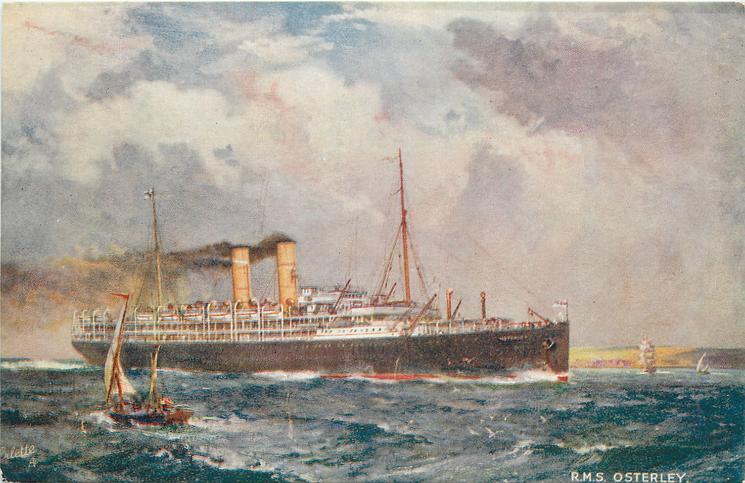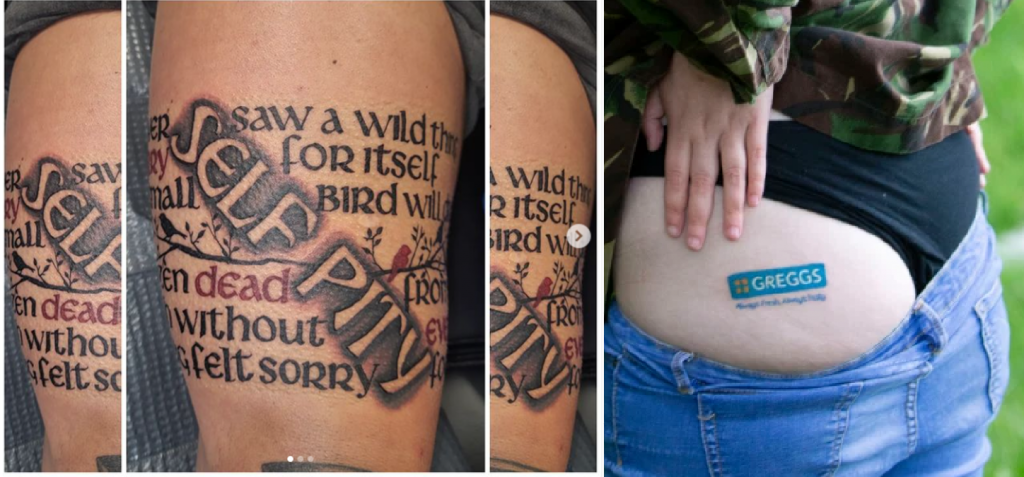
Postcard artist B. Gribble
On 26 February 1922 Lawrence sailed from Naples aboard the R.M.S Osterley heading towards Ceylon to meet a friend ‘who is taking Buddhism terribly seriously’. As Lawrence was want to do, he had to convince himself he was doing the right thing in leaving the comfort of his home in Sicily. He does this in typically dismissive fashion in a letter to Norman Douglas on 4 March 1922: ‘Thank the Lord I am away from Taormina, that place would have been the death of me after a little while longer’.
His latest sojourn would see him travel at 5mph along the Suez where he would observe palm trees and Arabic men plodding by on camels. This tranquillity contrasted with Mount Sinai which he described in a letter to S.S. Koteliansky on 7 March as ‘like a vengeful dagger that was dipped in blood many years ago, so sharp and defined’.
Lawrence was acutely aware of his immediate environment and had the wonderful ability of being able to see the world from all perspectives. ‘Being at sea is so queer’ he wrote to Rosalind Baynes on 8 March ‘it sort of dissolves for the time being all the connections with the land, and one feels like a sea-bird must feel’.
When the land beckons him to Ceylon, everything appears to be fine in his temporary accommodation at Kandy. On the 24 March he sends his sister Emily a bit of hand-made lace and describes sitting high up on a verandah watching chipmunks and chameleons and lizards. But despite the lovely view, it is so hot he has to wear a sun helmet and white suit. ‘If one moves one sweats’. Lawrence is not very good at sitting still – he will later chastise the buddha for not getting up – and by the 28th March he has confessed to Anna Jenkins that ‘I don’t feel at all myself. Don’t think I care for the east’. By the 30th Robert Pratt Barlow is informed ‘I do think. still more now I am out here, that we make a mistake forsaking England and moving out into the periphery of life. After all, Taormina, Ceylon, Africa, America – as far as we go, they are only the negation of what we ourselves stand for and are: and we’re rather like Jonahs running away from the place we belong’.
Despite this temporary fondness for his country of birth, Lawrence never stopped running. Since his self-imposed exile of 1919 he would continue to big places up, get irritated by them, then move on. How short his life may have been and how little he would have written had he found lasting contentment anywhere.
The D.H. Lawrence Memory Theatre, as well as my editorship of the Lawrence Society bulletin, has led me to reading Lawrence’s letters in chronological order so that I can map out what he was doing on each day exactly one century ago. If you would like to join me in this pursuit you need to pick up a copy of the Cambridge edition Volume IV (1921-24). As he dies in 1930, I only have eight years of this pleasure to go.

The contrast of our respective fates has not been lost on me. Lawrence is constantly on the move while I am constantly stationary. Whereas he is on the deck of a ship observing flying fish and black porpoises ‘that run about like frolicsome little black pigs’ I am googling phalluses for artefact three in the memory theatre and scrolling through Instagram wondering why one person got a Gregg’s tattoo on their bum during lockdown and another person had Lawrence’s poem ‘Self Pity’ tattooed on their arm. Something tells me nobody will be looking up this blog on this day in one hundred years time…
An almost identical version of this blog was originally published on The Digital Pilgrimage
Further reading
- James Boulton, Elizabeth Mansfield and Warren Roberts (ed). The Letters of D.H. Lawrence (Vol IV 1921 – 24). Cambridge University Press. 1987
- Osterley: Passengers in History at passengers.history.sa.gov.au
- History of British Ceylon 1796 – 1900 britannica.com
- Ceylon colony britishempire.co.uk
